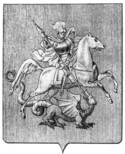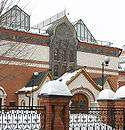Coat of arms of Moscow
| Coat of arms of Moscow | |
|---|---|
 | |
| Details | |
| Adopted November 23, 1993 |
The coat of arms of Moscow depicts a horseman with a spear in his hand slaying a basilisk and is identified with Saint George and the Dragon. The heraldic emblem of Moscow has been an integral part of the coat of arms of Russia since the 16th century.
Pre-Muscovite Russia
The emblem had its origins in the Byzantine tradition of depicting a patron saint of the ruling monarch on his seal and coins. Yaroslav the Wise was the first Russian ruler whose patron saint was Saint George. Accordingly, he built several cities and churches in the name of that saint.
Saint George was also the patron saint of his great-grandson, Yury Dolgoruky, who founded the city of Moscow. The name "Yury" is Russian for "George". Yury is thought to have honored his patron saint on his coins which represent a standing warrior holding a sword in his right hand. Yury's elder brother, Mstislav the Great, also used a seal featuring a horseman slaying a basilisk. According to some theory, this might have been a reference to St. George as the patron saint of England, since Mstislav's maternal grandfather was the last Anglo-Saxon king of that country, Harald II.
A century later, Alexander Nevsky resumed this usage. A lot of his coins depict a horseman slaying a basilisk or dragon, though the latter is not always visible. Alexander's motivation for reverting to Mstislav's emblem is disputed. It is possible that the image referred to his own victories over the Swedish and German crusaders in the Battle of the Neva and Battle of the Ice.
Muscovite Russia
Alexander's great-grandson, Ivan II, was the first ruler of Moscow to employ as his emblem the standing warrior with a sword in his hand. Ivan's son Dmitry Donskoy chose to represent this warrior riding a horse with a spear in his hand. Historians traditionally connect Dmitry's symbol with his victory over the Mongols in the Battle of Kulikovo, although historical clues are scarce. At about the same time, a similar symbol, the Pogonia, emerged as a state emblem in the rival Grand Duchy of Lithuania.
The symbol of the horseman slaying the dragon passed down through the generations: from Dmitry to his son Vasily I, then to Vasily II and Ivan III. A coin which featured the image became known as kopeck, from kopyo, the Russian word for "spear".
Ivan III used the triumphant horseman as a state emblem of Russia on his seal from 1479. In 1497, it was replaced with the double-headed eagle, popularly interpreted as a symbol of Ivan's marriage into the last ruling dynasty of the East Roman Empire, thus illustrating his claim to the Byzantine political and cultural heritage.
Both emblems had been used on state seals alternatively until 1562, when the first Russian tsar, Ivan IV the Terrible, combined them by placing a heraldic shield with the triumphant horseman to the chest of the double-headed eagle. This layout has become known as the coat of arms of the Russian Empire and then of the Russian Federation.
Imperial Russia

.png)
At first the charging horseman was interpreted as showing the figure of the ruling tsar slaying an enemy intruding into the Russian lands. This attitude was clearly expressed by the Muscovite statesman Grigory Kotoshikhin, among others. On the title page of the 1663 Bible, the heraldic horseman appears to have the face of Tsar Alexis.

The foreigners visiting Muscovy were the first to notice the emblem's resemblance to the traditional iconography of Saint George and the Dragon. Although during Peter I's reign the horseman was still represented with a crown and his face bore some resemblance to Peter's, this Westernizing monarch was the first to identify the heraldic horseman as St. George.
A learned Italian heraldist in Peter's service, Count Santi, associated the horseman with St. George as the patron saint of the prince who founded Moscow. In 1730, Santi prepared the first detailed description of the heraldic emblem of Moscow, which, drawing on the traditions of Western heraldry, named the horseman as St. George. In Santi's version of the emblem, set against the red field appears a white knight riding a silver horse and charging with his spear against a black dragon reminiscent of Zilant, a heraldic symbol of Muslim Kazan. With several minor modifications, this emblem was officially confirmed December 20, 1781, during Catherine II's municipal reform which involved standardization of the municipal heraldry.
In 1883, it was decided to bring the colours of Moscow's emblem in line with the three colours of the flag of Russia. The colour of the dragon was changed from black to white and the horseman's cloak was altered from gold to azure. These colours do not appear to correspond to the colour scheme traditionally used in Russian icons depicting Saint George and the Dragon. In 1903, the ancient colour scheme was revived by painter Viktor Vasnetsov in his design of the Tretyakov Gallery façade, whose entrance also displays a large effigy of St. George and the Dragon.
20th century
.svg.png)
After the Russian Revolution, the heraldic symbols of the Russian Empire were banned. On September 22, 1924, the Moscow Soviet adopted a new emblem of Moscow which featured a red star, the sickle and hammer symbol, and the Revolution Monument in Moscow. The Soviet emblem failed to gain popularity, however, and was rarely used. After the dissolution of the Soviet Union, the heraldic representation of Moscow reverted in 1993 to the version used between 1883 and 1918, with some minor modifications.
As the Russian Orthodox Church does not allow sculptural representations of saints, no statues of Saint George and the Dragon were erected in Moscow prior to the Revolution. After the emblem was restored on November 23, 1993, a cluster of statues on the subject were unveiled in Poklonnaya Gora, Tsvetnoi Boulevard, Manege Square, and other places in Moscow. Most of these were sculpted by Zurab Tsereteli, who also had other versions of the subject installed in such cities as New York.
References
- (Russian) Coat of arms of Moscow: History and pictures
- (Russian) Coat of arms of Moscow: History and pictures
External links
![]() Media related to Coats of arms of Moscow at Wikimedia Commons
Media related to Coats of arms of Moscow at Wikimedia Commons